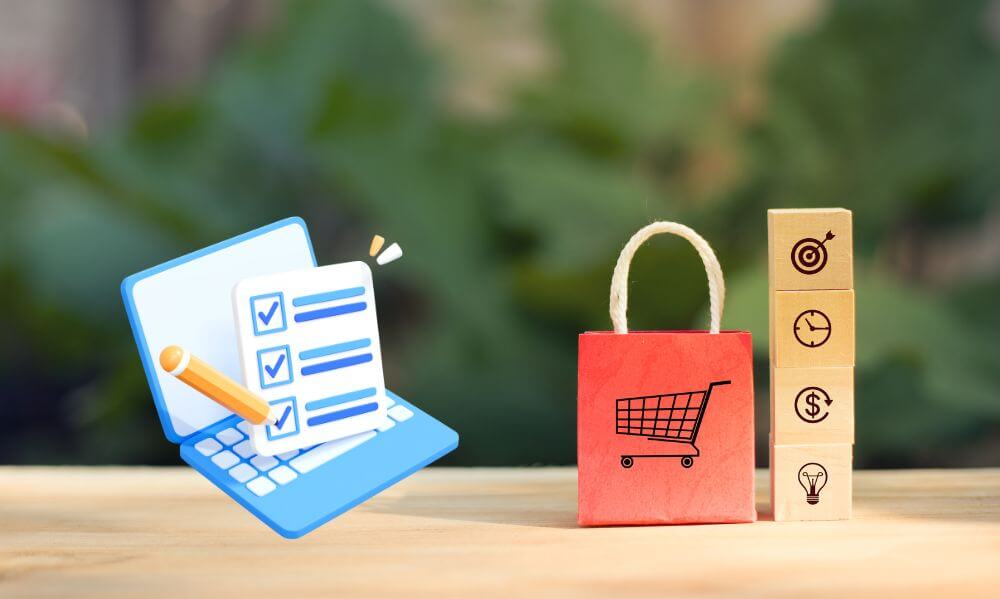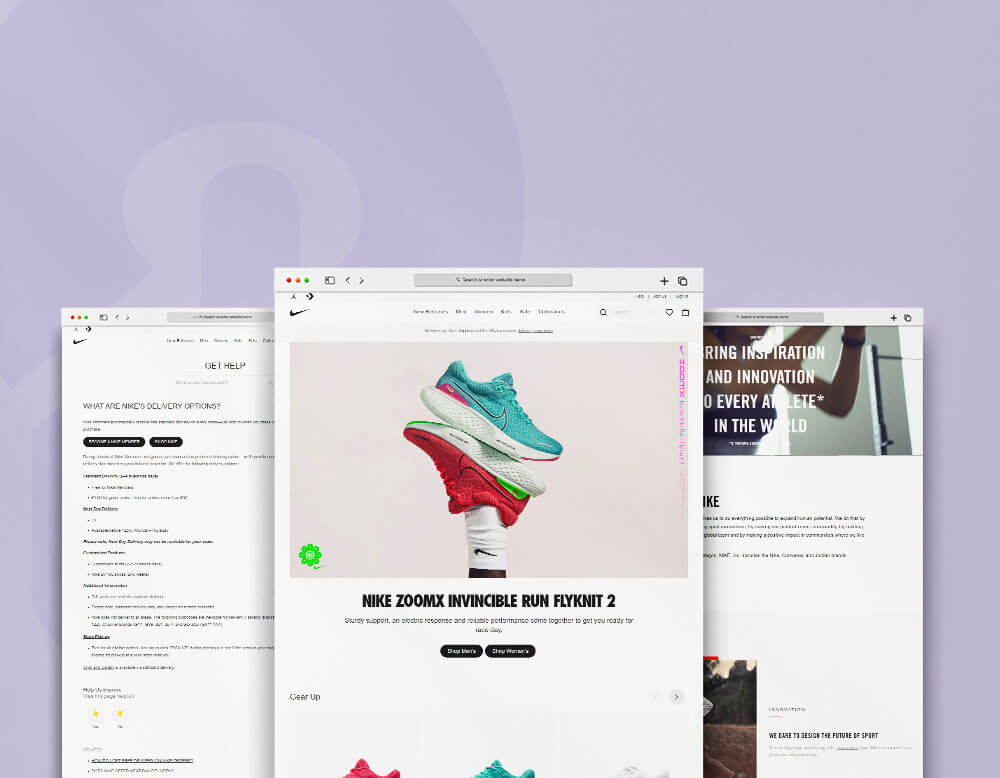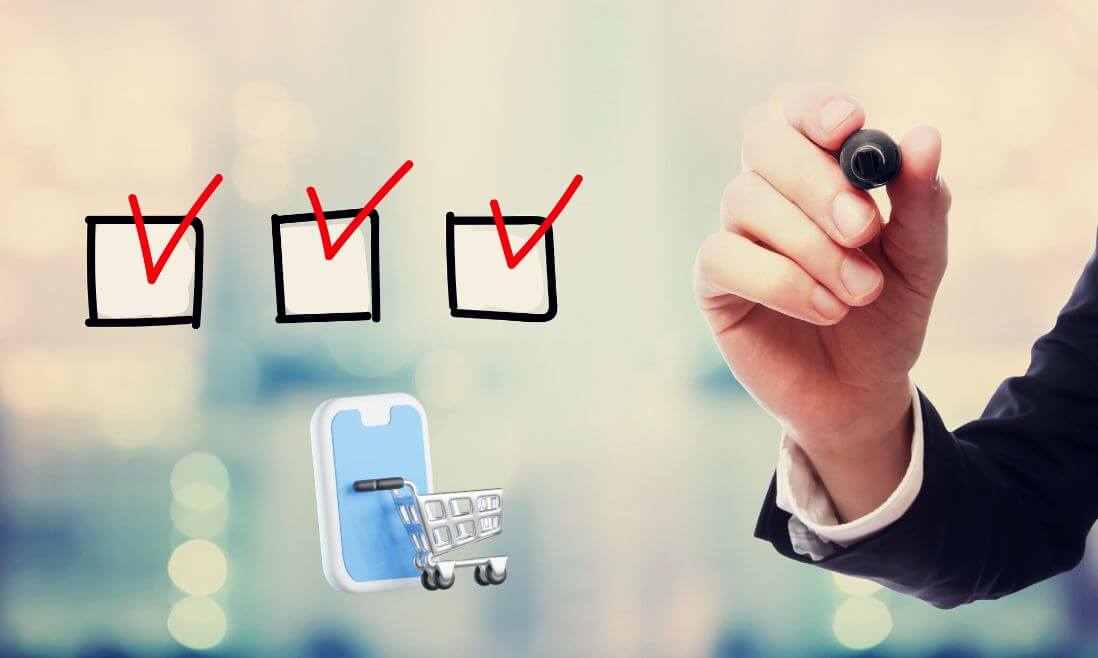Creating an eCommerce store might be complicated, especially if you’re a newbie. You could be confused as to what to do first. As a result, you do a little bit of everything in any direction you like. Unfortunately, this may lead to the omission of certain steps. We’ve put together a helpful eCommerce checklist for new store owners to ensure you’re prepared for success. Look at the eCommerce launch checklist below, and save it for future use.
Contents
What Is An Ecommerce Checklist?

An eCommerce checklist (or eCommerce website checklist) is a list of actions that must be completed to launch an online store successfully. It assists you in considering the activities, processes, and assets that must be streamlined before any store launch.
Why Is An Ecommerce Checklist Important?
A regular checklist ensures that no steps or items in a process are overlooked or omitted. Similarly, an eCommerce checklist can assist you in providing a seamless launch of your online store.
Many ambitious eCommerce entrepreneurs are intimidated by the processes they must take in the early stages of their business.
You may overcome this issue and smash it out of the park with an eCommerce checklist. So, to help you get started, we’re releasing the checklist many successful entrepreneurs we’ve highlighted used when they opened their businesses.
Ecommerce Website Pre-launch Checklist
1. Add your chosen sales channels

According to Statista, the number of worldwide digital buyers in 2021 is proximately 2.14 billion. As more people go for online shopping, they demand businesses to provide an omnichannel experience, particularly during peak shopping seasons, and merchants must meet buyers where they are.
To further improve customer experience, businesses should offer more sales channels. Learn how to select your business’s social media and marketplace channels, then integrate the available sales channels into your store. Here are some channels that you can take into account:
- eBay/Amazon
- Instagram and/or Facebook
- Google Shopping
- TikTok
- Buy Button and Checkout links
2. Add a custom domain
Using a custom domain for your website establishes your brand and makes it easier for visitors to remember your URL.
You should run a domain name search to see if your business name is available. If it is, and the name isn’t already registered as a trademark by another company, you can buy your domain name.
If your custom domain name isn’t accessible, it doesn’t necessarily mean you’ll have to start over.
A different top-level domain (TLD) can also be used. It is the last part of a URL: .com, .edu, and so on. Many websites, such as .gov and .org, use distinct versions of the domain name.
3. Review checkout experience and payment options
Before attracting customers to your store, ensure they’ll have a smooth purchase experience. Otherwise, you risk losing customers for good.
When testing your checkout process, be sure to keep the following in mind:
- On the checkout page, shipping costs are displayed.
- Customers can apply discount codes and adjust the order at checkout.
- Various payment options are available, including credit cards and PayPal.
- An order-tracking feature is available for customers.
- To confirm a purchase, an email is delivered.
- If offering worldwide sales and delivery, a language and currency switcher, and a shipping policy that clearly states who pays tariffs and taxes, are both available.
4. Prepare standard pages

An online store should include a few pages containing useful company information. Visitors may be interested in your background and how you started the company. Others will browse your website to learn more about your listed products.
Before utilizing a website builder to create product pages and checkouts, ensure sure you have:
- Home page: The home page is the most crucial page on your website. Your homepage contributes to your store’s overall appearance and feels and guarantees that customers can navigate to other pages easily. Your homepage includes links to your category and product pages.
- About page: Customers learn about the individuals behind your products on the about page. A solid About page should convey your company’s story and what it stands for, demonstrating a legitimate and trustworthy seller.
- Contact page: The contact page contains information about how consumers can contact you – address with a map, a phone number, an email address, and a contact form.
- Frequently Asked Questions (FAQ) page: Customers may want to know specific information about your product and policies. Help reduce their effort by offering an FAQ page.
- Terms of service: This page covers all legal aspects of your business, including services when someone shops at your store and what they may expect while visiting your website. When drafting your Terms of Service, it’s a good idea to seek legal advice.
- Privacy Policy Page: Similar to the Terms of Service page, you should consult with a lawyer to draft a lawful Privacy Policy and be as honest as possible regarding data usage. Consumers want to know what happens to their personal information when entering it into your website.
- Shipping detailed page: Customers who want to know when their purchases will arrive would benefit from a Shipping page. This page should include shipment times, areas, rates, and the various shipping methods.
- Return and refund policies page: Many shoppers verify an online store’s return policy before making a purchase. That is why it is critical to have a separate return and refund page on your website. The purpose is to provide details and processes for returns, exchanges, and returns.
5. Design listing pages
Customers find your products related to a specific category on a listing or category page. It helps keep your website organized and assists clients in quickly finding what they’re looking for. By employing listing pages to boost conversions and improve your overall SEO, you can take your business to the next level.
Make sure your listing pages have the following elements:
- A brief description of your category.
- Filtering and sorting options.
- Reviews and best-sellers.
- Availability of stock.
- Quick product view.
- There are internal links between categories and subcategories.
6. Design product pages
This page may be the ultimate cue for customers on whether to actually purchase a product. As a result, each product page must be optimized to the maximum extent possible.
Take note of the following:
- The add-to-cart button should be prominently displayed. Above the fold is a good location because it is always within reach of customers. Plus, use contrasting colors to make it stand out.
- Use high-resolution, professionally made images from various perspectives. In your theme, enable the product image zoom and 360-degree view functionality.
- Make a thorough product description. Emphasize the benefits of your items rather than the features. In other words, how your products improve and simplify your customers’ lives.
- Styles, sizes, colors, inventory tracking numbers, tax rates, currency, product weights, and other product-related components should all be checked.
- Present trust badges, reviews, testimonials, or other social evidence to gain customers’ trust.
7. Design a shopping cart page
The shopping cart is where customers check their chosen items before purchasing. This page’s purpose is to direct visitors to the checkout page.
To make an excellent shopping cart:
- Show product information such as names, photos, sizes, colors, and prices. This aids shoppers in remembering which things they desire and why they want them.
- Use a straightforward call-to-action (CTA) button, such as “Proceed to Checkout” or “Go to Checkout.”
- Allow easy cart adjustment, such as removing/adding goods, changing size/color/quantity, etc.
- Show social proof to keep customers trusting you and avoid unexpected shipping expenses, taxes, and hidden costs.
- Add a mini-cart widget to your page. It allows customers to add items to their cart without leaving the page they’re on.
8. Design checkout page
Cart abandonment is most common on the checkout page. As a result, ensure you go through it as thoroughly as possible.
A high-converting checkout page must:
- Provide a variety of standard payment choices.
- Maintain a straightforward process. Include only the key fields on the page. It’s recommended to go for a one-page checkout style.
- Offer guest checkout.
- Show a progress bar to let customers know how many steps remain to finish the transaction.
- Include a live chat option to provide immediate customer assistance during checkout.
- Show the order confirmation after payment is completed. Create a Thank You landing page to confirm the order and provide special discounts for future purchases.
You can learn from these examples of checkout pages from top brands.
9. Execute a content audit
You may become so engrossed in your job that you fail to notice minor errors such as spelling, grammar, or broken links. Going backward through the document, starting with the last paragraph and working to the top, will help you catch any faults you may have overlooked.
Consistency is one of the most crucial things in your text. As long as it’s on-brand, use an editorial style guide or your creative spelling, but make sure it’s consistent across your site.
On the technical side, examine for broken links and 404s, as well as any difficulties with picture rendering and mobile responsiveness. Examine your site on various browsers and devices to determine whether a bug is universal or exclusive to a particular device or browser.
10. Create Blogs and Media Pages
Additional content distinguishes you from your competitors and demonstrates to search engines that you are more than just an eCommerce site selling products. Therefore, creating a blog is a great idea.
Besides, you must be consistent with social media messages to promote your store. There are numerous social media networks to examine but concentrate on the ones your potential buyers use. Pay attention to your clients and determine how they spend their time online.
Keep in mind:
- Create a blog page and regularly post content related to your items.
- Build a presence on social media platforms like Instagram, Facebook, TikTok, and Pinterest.
- Follow influencers in your niche to understand what their audience is interested in and how you can incorporate it into your products.
- Make a list of hashtags in your social media posts, branded and non-branded.
- Get your products and brand features featured on price comparison websites, review websites, related forums, communities, Quora, and other similar sites.
- Showcase your website on online marketplaces to gain more attention.
11. Check eCommerce SEO

To drive conversions, eCommerce companies rely on social media, paid advertisement, and search engine optimization (SEO).
Most customers begin their search for a product on Google. Thus, ensuring your website appears when customers search for terms relating to your products or services is essential.
Ecommerce SEO entails several steps, including:
- Keyword research: Find and list the terms people might use to find your store.
- Keyword optimization: Product descriptions, category descriptions, meta title descriptions, H1s, and URLs should include your chosen keywords.
- Optimize images: To boost your chances of ranking highly for specific keywords, properly use “alt attributes” and picture meta descriptions.
- Schema markup: Using schema markup increases your chances of Google displaying rich snippets at the top of search results.
- Create a sitemap: Make a sitemap and upload it to Google so that spiders may find it. This aids in the categorization of your pages by Google.
- Optimize website performance: To make your website load faster and improve client experience, invest in a CDN, find the correct server, and compress your picture files.
- Use content marketing: Guest posting on blogs can help you rank for keywords and earn links to your high-value pages.
12. Optimize website for conversions
Conversions are crucial on an eCommerce site. To ensure that your store is optimized for high conversion rates, look at these tips:
- Demonstrate products through photos/videos.
- Show live chat to assist customers when needed.
- Make your website easy to navigate and fully responsive on mobile devices.
- Display countdown timers or stock countdowns.
- Improve the menu navigation. Make it simple for customers to find items.
- Ensure the site’s search function works well.
- Make it simple to search and see information about your products and services.
13. Install essential tools for your store
Tools are a terrific way to make your website more functional. Although not every tool will be necessary for your business, some may be able to assist you in increasing sales and visitors.
You’ll want to install tools to help with marketing, customer service, and conversions when you’re just getting ready to launch. You might, for example, use social proof software to display client testimonials on your landing pages to boost sales. You may add a tool that allows users to establish a wishlist or automates upselling and cross-selling products at checkout.
14. Set up an eCommerce help desk
Customers often communicate with a merchant via multiple channels (email, live chat, social media, etc.). If you don’t have a dedicated tool, managing all of this can become a nightmare.
Ecommerce help desk software is designed to assist you and your product or service online, putting everything in one place for better management. Moreover, it helps with tracking and organizing support data. Thus you may base on it to further improve your service.
15. Set up email marketing

Email marketing remains an effective strategy to create and keep a positive customer relationship.
The following are the eight most crucial eCommerce emails:
- Welcome email: Thank customers for signing up for your email list and set the tone for what’s to follow.
- Thank you email: Thank customers for purchasing from you and reassure them that their orders will arrive on time.
- Survey email: Send an email to consumers asking for feedback on their purchasing experience and experiences with your items.
- Card abandonment email: If shoppers leave products in their carts, encourage them to finish their transaction.
- Order confirmation email: Customers should confirm the order they just placed in your store.
- Upsell and cross-sell email: increase the average order value of your store by selling additional products to clients.
- Promotional offer email: Inform your clients about site-wide discounts, holiday specials, gifts, and so on.
- Customer loyalty and re-engagement email: Send emails to existing customers or customers who haven’t made a transaction in a certain amount of time.
16. Optimize all of your website’s photos
Slow-loading photos can degrade your site’s user experience and search engine rankings, and they’ve been linked to poorer conversion rates. Ensure that your marketing and product photos are optimized for fast load times.
Here are some other things you can do to speed up your page loads:
- When naming your photographs, be specific.
- Carefully consider your alt characteristics. For web accessibility and SEO, alt attributes are employed.
- Reduce the size of the pictures you’re using.
- Select the appropriate file type. JPEG pictures for photography and PNG images for graphics and icons are a decent rule of thumb for most web photos.
- Go over your thumbnails again. The importance of your company’s logo cannot be overstated. It’s how customers associate your eCommerce store’s name with an image.
- Put your images to the test.
17. Set up analytics
The key to operating a successful store is analytics. The appropriate data reveals what types of things your customers want and when they’re most inclined to buy.
Many store-building systems provide analytics and reporting, allowing you to measure metrics such as conversion rates and traffic. Many online enterprises, however, employ third-party solutions such as Google Analytics.
Using a combination of analytics tools can provide a more detailed picture of your customer’s journey, making it easier to figure out what you need to do to increase sales.
18. Develop an eCommerce marketing plan
You’ll want to ensure people know about your site once it’s live. A digital marketing strategy is the most effective approach to accomplish this. Document your business strategy so that when you go live, all you have to do is follow the steps you’ve already specified.
Make sure your marketing strategy incorporates the following:
- Goals and objectives – SMART (specific, measurable, achievable, relevant, and time-bound).
- Customers, identities, and markets to target. You must have a firm grasp of who you’re aiming for, what attributes characterize them, and where they’re located. Also, make sure you understand their spending power and habits.
- To put your strategy into action, you’ll need channels, strategies, and tools. List everything you’ll do to reach your goals in detail, whether it’s pay-per-click advertising, SEO, content marketing, influencer marketing, social media marketing, or email marketing.
- A holiday marketing calendar highlights the year’s most important holidays and activities. It’s also much better to have a holiday marketing strategy as soon as possible.
19. Integrate payment methods
Payment processors are the sole option for online retailers to collect sales. The eCommerce platform determines the payment gateway options; some mandate you to use a specific payment gateway, while others allow you to link with hundreds.
Regardless, setting up a payment processor account, getting accepted, and testing transactions are critical to ensure everything is in working order.
This is also a perfect moment to expand your site’s payment options. Conversions benefit from various approaches because some consumers prefer particular payment choices over others.
Here are some payment options to think about:
- Major credit cards.
- Debit cards.
- Google Pay.
- Apple Pay.
- PayPal.
- Bitcoin.
- Check.
- Money Order.
- ACH payment.
20. Test before Launch
This is the final step in our eCommerce checklist. Ensure your website makes an excellent first impression on visitors by properly testing it beforehand. Verify that everything functions correctly and that there are no broken links or pages that do not load. Your website should work properly on all devices (including mobile).
All store owners should continue testing monthly or quarterly, frequently in conjunction with analytics and performance statistics that may reveal problems or opportunities for the website.
Use the following strategies to test your online store:
- Activate A/B testing campaigns for specific areas of your site, from buttons to text and email messages to checkout.
- Compare the effectiveness of multiple CTAs per page with a single CTA per page.
- Examine the features and social media integrations of eCommerce apps.
- Test the functions of payment methods.
- Examine your browser’s compatibility.
- Check for responsiveness on mobile devices.
- Examine performance as well as SEO-related issues.
- Websites are evaluated for hero photos on the homepage, search buttons, all pages, pop-up forms, account pages, site loading speed, and security, among other things.
- Email marketing sequences are put to the test.
- Test orders on mobile and desktop. Check to see that all of your integrated apps are up and running.
Conclusion
This lengthy eCommerce checklist could make you feel a little overwhelmed. And that’s perfectly normal. Depending on your store’s requirements, you may skip a few things. However, having a checklist is usually a good idea so that you can launch your eCommerce site with confidence. We hope that knowing every step you’ll have to take over the next few months will help you get one step closer to the success you desire.
If you have any requirements related to building a solid e-commerce store, Tigren can be your best assistance. We offer excellent e-commerce services at excellent prices. With an expert team working on e-commerce web design and development for many years, we know how to make your online store outstanding.

Read more:

